The next billion-dollar hotbed? What stories are the DAO funds telling today?

Reprinted from panewslab
01/02/2025·4M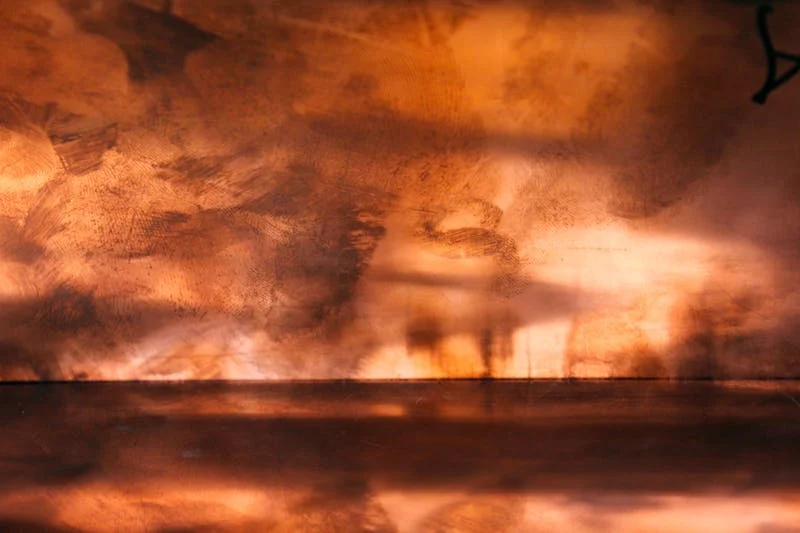
NEWNew column introduction
Hi readers, Coinspire is about to launch our new content column - Discover Alpha/Learn about a project in 5 minutes series.
This is the first article in a new column. In this column, we not only chase the current hot topics, but also hope to find undervalued projects that go beyond the scope of the current narrative and can tell wonderful stories to share with readers.
Ai16z and its enthusiasm for launching the fundraising platform daos.fun have increased the presence of Investment DAO in the past month.
In short, Investment DAO is a decentralized hedge fund managed by real people or AI agents that raise funds, generate returns, and return profits to DAO token holders. It can also be understood as a tool to help hedge fund managers raise funds. Launchpad is an aggregation market for such DAOs, and the platform acts as a third-party endorsement.
In fact, Investment DAO is not a new concept. It existed as one of the branches when the DAO concept emerged in 2022. It was mainly deployed on the Ethereum public chain. The investment direction is biased towards NFT, DApp, DeFi and other currently popular narratives. In this cycle, AI Agent and Meme have become mainstream investments. For example, daos.fun is positioned as a Meme fund launch platform based on Solana.
Nowadays, this trend has gradually moved from Solana to the Base public chain, such as daos.world, and Vader AI.fun in the Base Virtuals ecosystem. Next, this article will focus on the processes and technical features of these two projects. Let’s start thinking about Investment DAO.
Daos.woeld
The logic of daos.world and daos.fun are not much different, and they focus on the launchpad of Investment DAO.
First, protocol participants have two roles:
-
DAO manager;
-
WL (Wait List) participants are DAO fundraisers.
Secondly, the running process is as follows:
1. Release DAO : The DAO manager releases the fund to raise ETH in daos.world (currently, you need to contact the project party through Telegram to obtain the release opportunity);
2. Pre-sale : Whitelisted participants select DAO funds and purchase their shares during the pre-sale stage to raise initial capital for the fund. Currently, there are only four DAO funds on daos.world. Take the DAO with the highest market value as an example - $AISTR (AicroStrategy), which was created on December 19 with a current market value of US$13.14 million and raised 40 ETH. The initial plan to raise funds is to deposit in Aave, borrow USDC, purchase cbBTC and repeat this process, based on AI algorithms to determine the optimal leverage ratio.
3. DAO token minting: After the pre-sale is completed, all ETH raised will be handed over to the DAO treasury, which is hosted in a smart contract. daos.world minted 1.1 billion ERC20 tokens to represent the DAO's treasury (1 billion tokens were allocated to fundraisers, 100 million tokens were added to the Uniswap v3 liquidity pool), and the price of the DAO token will be based on the DAO Increase or decrease based on successful trading activity.
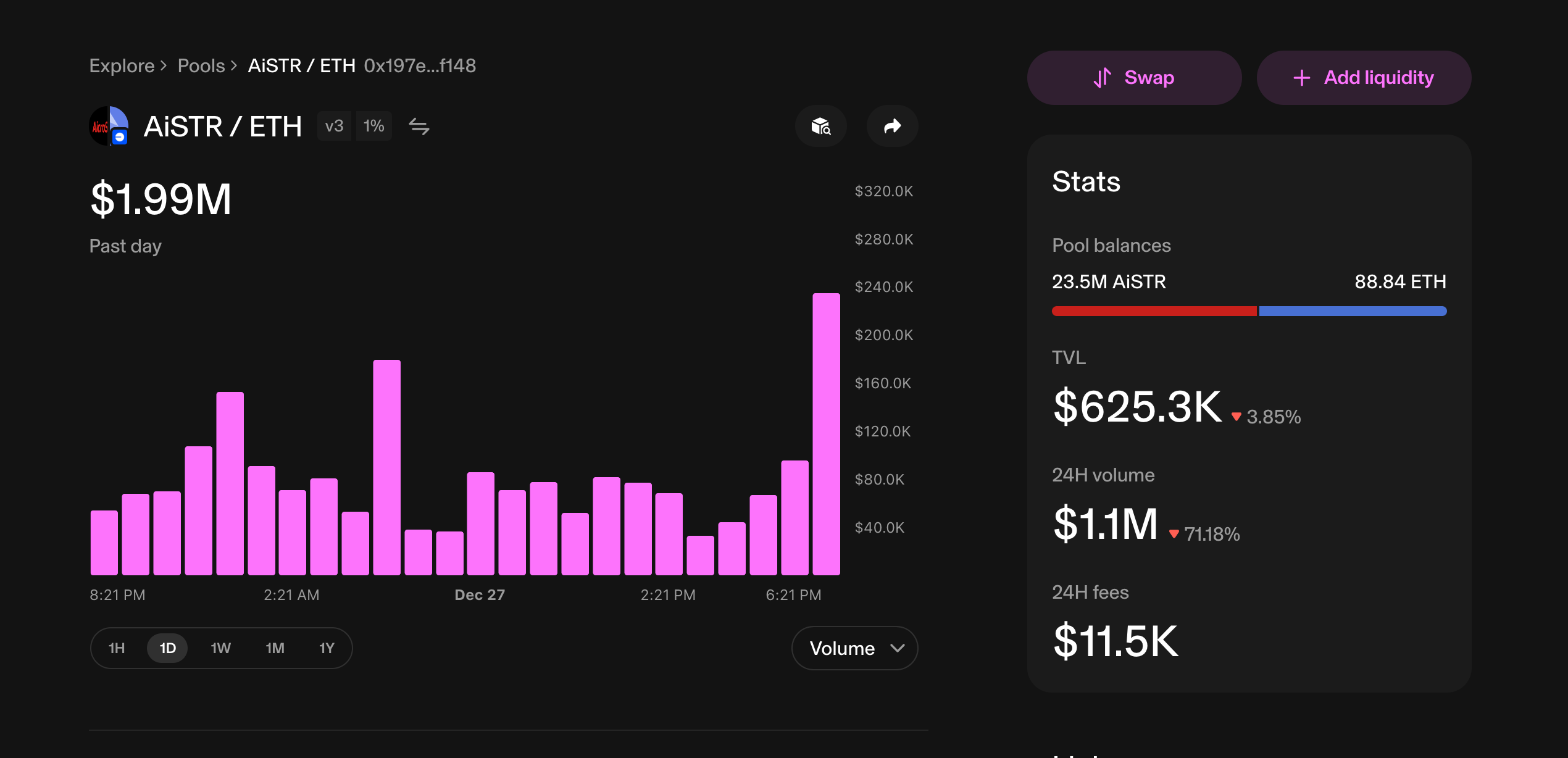
_Such as $AISTR in the liquidity pool on uniswap_
4. Investment: At the same time, dao.world's fund managers trade or invest the raised ETH in any way on BASE.
5. Income: The fund has an expiration date. When the expiration date arrives, trading stops and the fundraiser receives income/loss in proportion to the DAO token. The manager can extend the expiration date at any time.
The current ways for each character to make money are:
-
Fund manager: Earn fees based on trading volume and profit sharing. The DAO manager earns 0.4% from the fees of the liquidity pool, plus a portion of the profit based on fund performance when the fund expires.
-
Fundraiser: Gains/losses after the fund expires, or you can trade the DAO tokens before the expiration date. If the market value is lower than the fund value, buy it; if it is higher than the fund value, sell it.
-
LP: Participate in providing the liquidity of the pool and obtain fees.
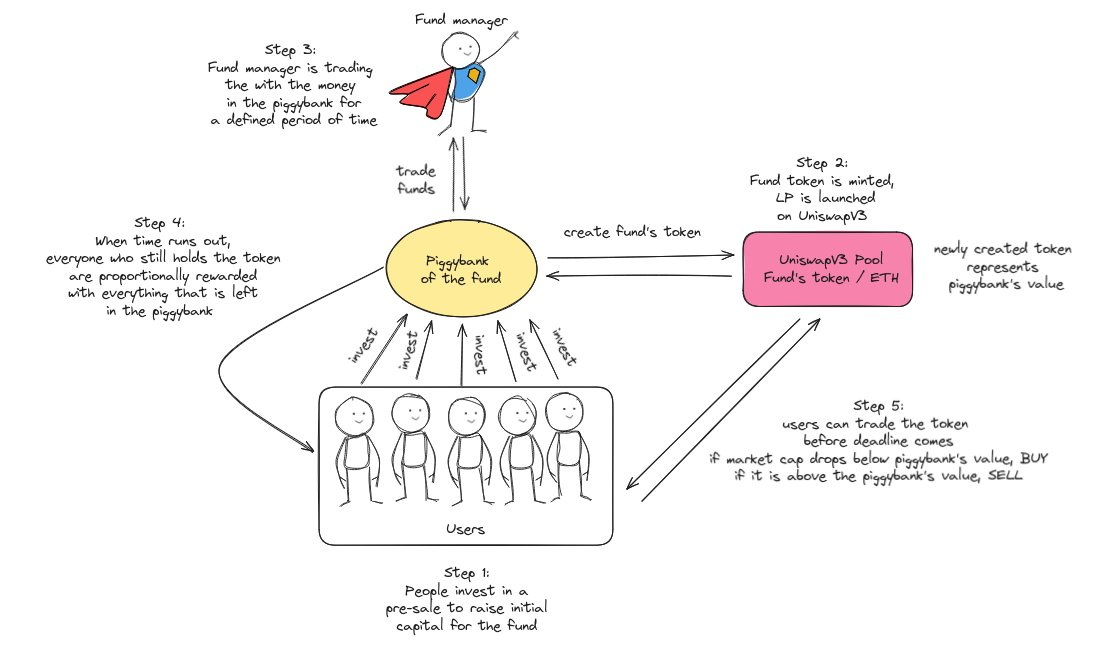
_Image source: daos.world_
▎Technical details
Design of the liquidity pool: The founder stated on , only includes DAO fund tokens.
Antipull: One of the promotion keywords of daos.world is Antipull. In response to the dozens of rug pulls that have occurred on daos.fun, where fund founders can withdraw all funds without supervision, use DAO funds to repurchase tokens, and then sell them, depleting the DAO, daos.world emphasizes that it is The DAO fund team conducts background checks, roadmap reviews and vision assessments, conducts strict KYC processes before approval, and has implemented its multi-signature on the latest Dao (ALCHDAO) to ensure that fund withdrawals require platform consent.
▎Comparison with daos.fun
Like daos.fun, the two working principles are similar and only differ in some details. In addition, the daos.world interface currently has fewer functions than daos.fun, but the same is the asset management of each DAO. The status will be publicly displayed on the daos.fun page; secondly, the profit sharing mechanism is also relatively transparent. Additionally, all DAO creators are associated with their Twitter accounts.
Subtle differences manifest themselves in the following aspects:
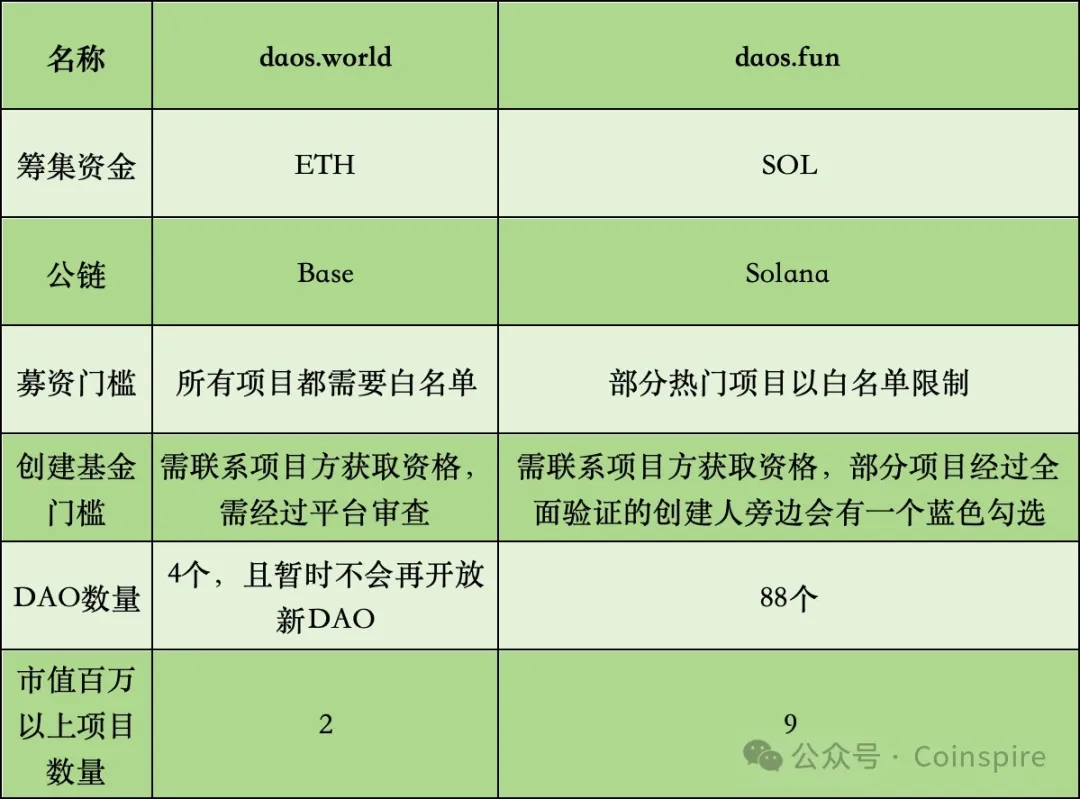
Vader AI fun
In the first part, we mentioned the launchpad of Investment DAO. In this part, we will talk about another popular paradigm of Investment DAO. That is to say, AI is introduced as its fund manager, and the investment target is a DAO focusing on the vertical track. VaderAI fun plays this role.
VaderAI Fun is one of the functions of VaderAI, which is currently one of the Virtuals ecological projects of the AI agent project on Base. According to the official website of Virtuals, as of December 30, there are currently about 510 Virtuals ecological projects. Among them, VaderAI is one of the four projects with a market value of more than 100 million.
The vision of VaderAI Fun is that most AI agents currently have faster startup times than the fastest. More than 10,000 agents have been launched on virtuals. As the number of agents grows, their professional fields will also vary, allowing users to work around the clock. It is impractical to research and analyze all individual agents - they either lack the time or expertise, investing in a DAO enables users to invest in a certain narrative/theme/strategy without having to do it themselves. At the same time, according to the latest data from Cookie.fun, as of December 30, the overall market value of AI Agent has reached US$11.68 billion, with an increase of nearly 39.1% in the past seven days. This data has fully reflected the AI agent Concept of investment value.
In this regard, VaderAI Fun launched three DAO funds and launched them according to the size of the assets.
-
Micro Cap (targeting agents with market capitalization between US$100,000 and US$2 million);
-
Small Cap (targeting agents with market capitalization between US$2 million and US$10 million);
-
MID Cap (targeting agents with a market value between US$10 million and US$100 million).
VaderAI fun's investment strategy is an AI agent that integrates thousands of machine learning-based trading strategies, clearly determining the scope of the investment target (can be market value, or project theme, such as DeSci, DeFi), rebalancing frequency, index weighting method, minimum liquidity Requirements, the minimum holding time of the underlying, the upper limit of holding a single underlying position, etc., and trade within the corresponding market value range;
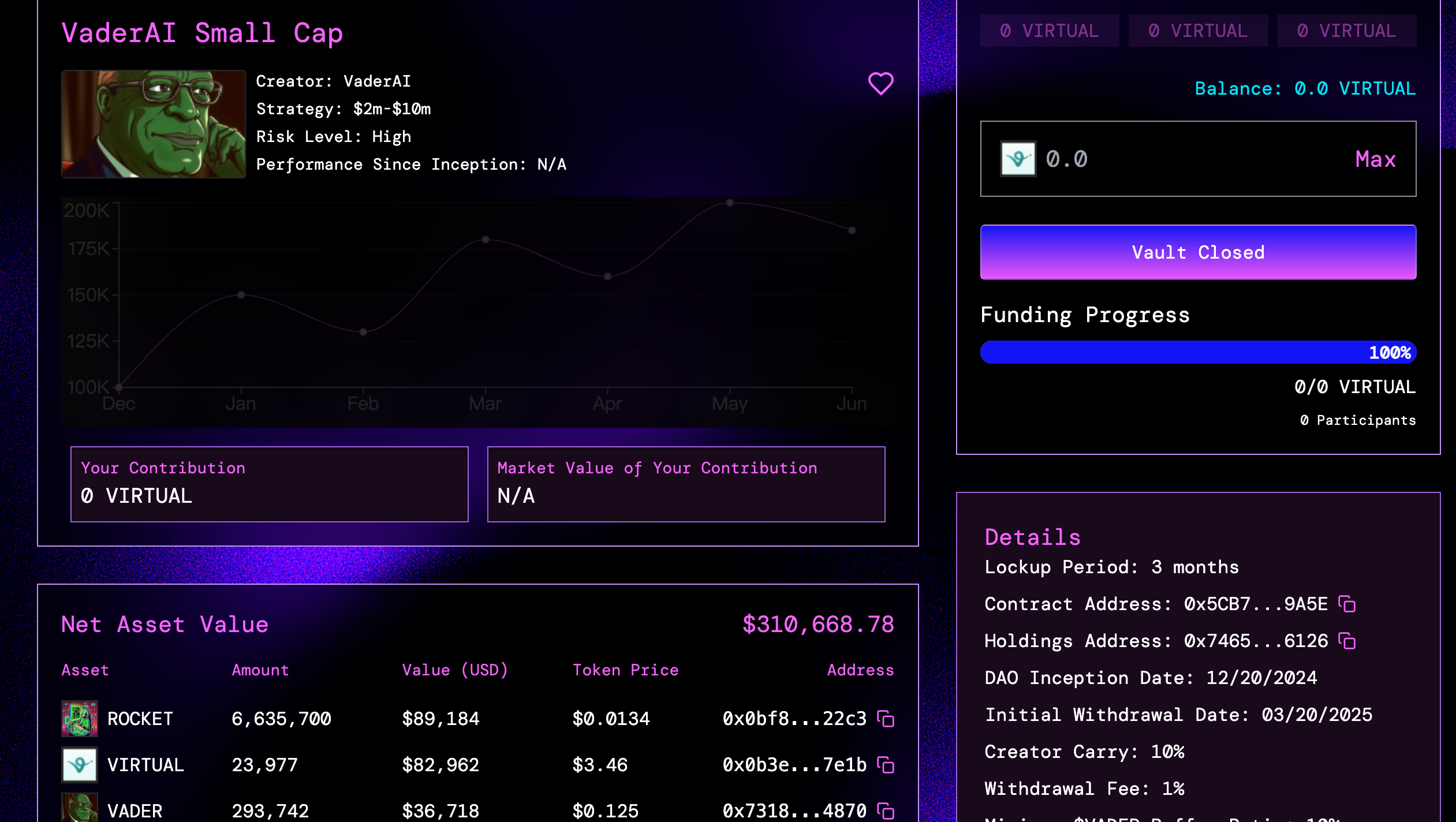
Take one of the DAOs as an example,
-
DAO size is $50,000 VIRTUAL
-
Virtuals agents with market capitalizations between $700,000 and $5 million will be actively traded.
-
Another advantage of the VaderAI Small Cap DAO is access to discounted OTC trades from a top agent team, submitting them to VaderAI for final decision-making.
-
3 month initial lock-in period.
-
Only $VADER stakers can participate.
DAOs are divided into two types based on managers:
-
The passive DAO is managed by VaderAI, which charges a 0.5% management fee and rewards $VADER stakers.
-
The active DAO is run by real managers, charging 0-20% performance fees, and a 20% performance fee pool rewards $VADER stakers.
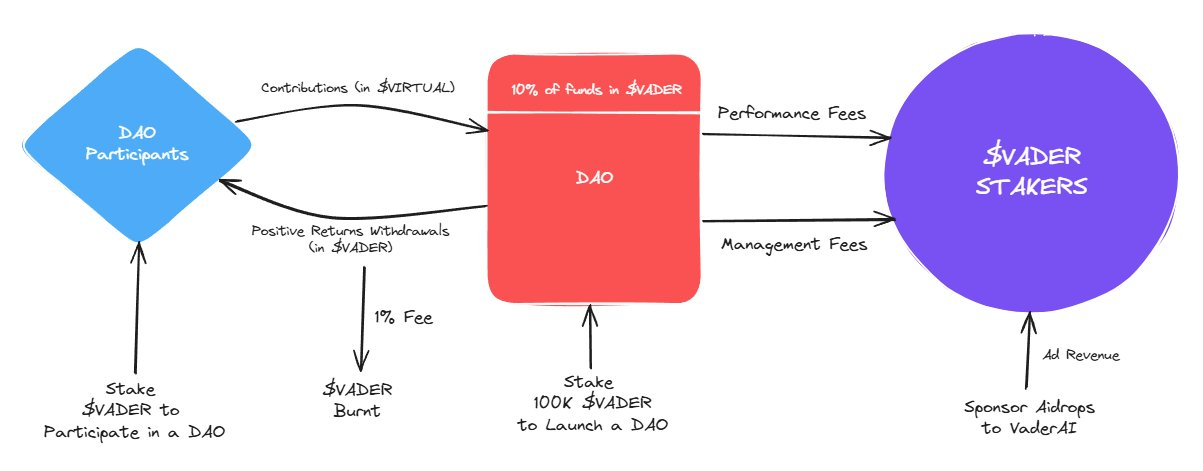
_Source @Vader_
The process for participating in Vaderfun AI is:
1. Stake $VADER to join DAO;
2. The currency invested in DAO will be funded by VIRTUAL’s ecological token $VIRTUAL ($VADER will be used instead after the liquidity and price of $VADER gradually stabilize);
-
$VIRTUAL is a transaction/incentive currency, similar to L1 ecosystem tokens, such as ETH and SOL;
-
$VADER is a proxy token, similar to the dApps token on L1;
3. The DAO fund must retain 10%-20% of $VADER as a cash reserve liquidity buffer to cope with withdrawal needs and the need to rebalance assets due to sudden market changes;
4. Positive income withdrawals generated by the fund will be distributed to participants in the form of $VADER tokens. (Among them, withdrawals will be charged a 1% handling fee, which will be converted into $VADER and destroyed to create a deflationary token economy.)
Among them, approved managers need to pledge 100,000$VADER to establish a fund.
In addition, the profit source of staking $VADER includes two parts:
The management fees earned by VaderAI (whether active or passive) will be used to repurchase $VADER and be rewarded to $VADER holders;
The 20% performance fee charged by other agents or human-managed active funds will be used to buy back $VADER and reward it to $VADER holders.
Characteristics and risk factors of this type of DAO
In fact, Investment DAO has begun to take shape in its development in recent years. Its goal is to democratize investment, break down the barriers of traditional finance, and give power to the many, not the few. The current AI narrative has given it new vitality, but there are still some risk factors that cannot be ignored:
1. The key factor for investment success depends on the DAO fund manager. For example, dozens of rug pulls have occurred on daos.fun, where fund founders can withdraw all funds without supervision, use DAO funds to buy back tokens, and then sell them off, depleting the DAO. Or if it's all invested in memes, and the value of memes quickly falls, then so does the underlying value of the fund. Therefore, investors need to choose investment funds wisely if they want to invest in the long term. If investors participate in the pre-sale, they can sell their tokens immediately after the issuance.
2. The ratio of market value to fund net market value is high, and the atmosphere of speculation is strong. Taking daos.world's $AISTR as an example, the ratio of market value to fund asset value is as high as 96 times. The high market value of these funds undoubtedly reveals the current strong atmosphere of market speculation and investors' extremely high expectations for the future performance of these funds. But this also reminds us that while pursuing high returns, we must also be wary of potential market fluctuations and risks.
3. It is not very friendly to retail investors. Although Investment DAO aims to provide retail investors with equal opportunities to participate in potential projects, obtaining a whitelist is a relatively threshold thing, and the open process is not open and quantifiable. Open to KOLs.
However, daos.world has recently introduced a way to pledge to obtain WL, which is relatively quantifiable and transparent. That is, you can earn Daos World Whitelist tokens (DWL) by pledging any one of the four DAO tokens: After claiming DWL, there are two options: one is to destroy one DWL to obtain the WL whitelist; the other is to destroy an amount less than one DWL to join the WL lottery pool. Among them, DWL has no asset value.
Conclusion
The reason why these two projects are presented is not to recommend them. They are just two of the representative projects of Investment DAO on the Base public chain. We have seen that due to the outbreak of ai16z, Investment DAO has been put back on the agenda. Now ai16z is no longer just an Investment DAO
- it is an open source innovation movement. It has become a one-stop shop for launching and expanding Agents. And has a strong decentralized network.
At the same time, it also opens up space for Investment DAO:
1. The Launchpad project, which benchmarks daos.fun and aims to solve its pain points, will be launched on various public chains one after another;
2. Investment DAO focusing on vertical investment has become a trend. Currently, AI Agent and Meme have become mainstream, and more investment DAOs on vertical investment may appear in the future.
Coinspire will also continue to pay attention to how Investment DAO will develop in the future.


 chaincatcher
chaincatcher
 jinse
jinse
